| Article ID | Journal | Published Year | Pages | File Type |
|---|---|---|---|---|
| 4642679 | Journal of Computational and Applied Mathematics | 2007 | 16 Pages |
The nonlinear Helmholtz (NLH) equation models the propagation of intense laser beams in a Kerr medium. The NLH takes into account the effects of nonparaxiality and backward scattering that are neglected in the more common nonlinear Schrödinger model. In [G. Fibich, S. Tsynkov, High-order two-way artificial boundary conditions for nonlinear wave propagation with backscattering, J. Comput. Phys., 171 (2001) 632–677] and [G. Fibich, S. Tsynkov, Numerical solution of the nonlinear Helmholtz equation using nonorthogonal expansions, J. Comput. Phys., 210 (2005) 183–224], a novel high-order numerical method for solving the NLH was introduced and implemented in the case of a two-dimensional Cartesian geometry. The NLH was solved iteratively, using the separation of variables and a special nonlocal two-way artificial boundary condition applied to the resulting decoupled linear systems. In the current paper, we propose a major improvement to the previous method. Instead of using LU decomposition after the separation of variables, we employ an efficient summation rule that evaluates convolution with the discrete Green's function. We also extend the method to a three-dimensional setting with cylindrical symmetry, under both Dirichlet and Sommerfeld-type transverse boundary conditions.
